Fishes
Media
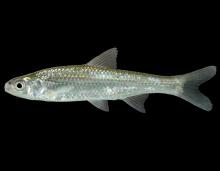
Species Types
Scientific Name
Hybognathus hayi
Description
The cypress minnow, like its Bootheel swampland habitat, is in danger of vanishing from Missouri. On the forward part of this fish's side, note the distinct cross-hatched pattern made by the dark-edged scales.
Media

Species Types
Scientific Name
Labidesthes sicculus
Description
The brook silverside is a little fish that is very active in the daytime and on bright, moonlit nights.
Media
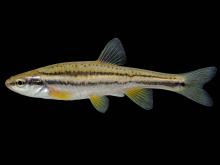
Species Types
Scientific Name
Chrosomus erythrogaster (formerly Phoxinus erythrogaster)
Description
The southern redbelly dace has two dusky stripes separated by a broad golden stripe along the side. The bellies of males turn brilliant red in spring. It lives in small creeks and spring branches of the Ozarks with permanent flow of cool, clear water and a gravel or sand bottom.
Media
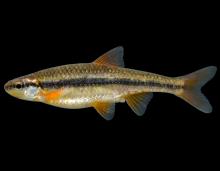
Species Types
Scientific Name
Notropis nubilus
Description
The Ozark minnow is small and slender, with a prominent dusky stripe along the midline that extends forward past the eye. It is one of the most common minnows in the Ozark uplands.
Media
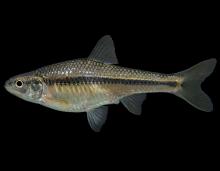
Species Types
Scientific Name
Notropis topeka
Description
Found in only a few Missouri streams, the Topeka shiner is an endangered native minnow that has declined dramatically because of environmental pollution, siltation, and loss or alteration of habitat.
Media
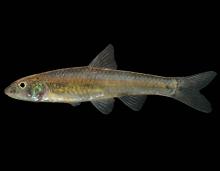
Species Types
Scientific Name
Notropis sabinae
Description
In Missouri, the Sabine shiner is known only from a short stretch of the Black River in Butler County. This slender, silvery minnow has a bluntly rounded snout that projects slightly beyond the upper lip.
Media

Species Types
Scientific Name
Nocomis biguttatus
Description
The hornyhead chub is a moderately large, slender minnow with a rather large, nearly horizontal mouth. Males commonly have bony projections on top of the head. Occurs in clear Ozark streams with permanent flow and clean gravel.
Media

Species Types
Scientific Name
Notropis maculatus
Description
One of the rarest Missouri minnows, the taillight shiner is known only from a few localities in southeast Missouri, in habitats representing the last remnants of low-gradient streams and swamps once common in that region.
Media
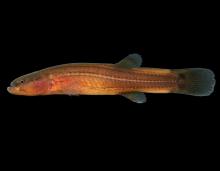
Species Types
Scientific Name
Forbesichthys agassizi
Description
The spring cavefish is the only cavefish in our state that has eyes, however small, and whose body is yellowish brown or brown; our other cavefishes lack eyes entirely and are pale and nearly colorless.
Media
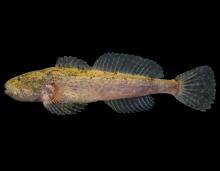
Species Types
Scientific Name
Cottus specus
Description
The grotto sculpin is a rare fish adapted cave conditions. It has recently been designated an endangered species under the Federal Endangered Species Act. It's found only in Perry County, Missouri.
See Also


Media

Species Types
Scientific Name
Amphiuma tridactylum
Description
The three-toed amphiuma is an eel-like, completely aquatic salamander. It has very small forelimbs and hind limbs, each with three tiny toes. In Missouri it’s found only in the Bootheel region.
Media

Species Types
Scientific Name
Siren intermedia nettingi
Description
The western lesser siren is an eel-like, aquatic salamander with external gills, small eyes, small forelimbs with four toes, and no hind limbs. In Missouri, it’s found mostly in the Bootheel and northward in counties near the Mississippi River.
About Fishes in Missouri
Missouri has more than 200 kinds of fish, more than are found in most neighboring states. Fishes live in water, breathe with gills, and have fins instead of legs. Most are covered with scales. Most fish in Missouri “look” like fish and could never be confused with anything else. True, lampreys and eels have snakelike bodies — but they also have fins and smooth, slimy skin, which snakes do not.





















